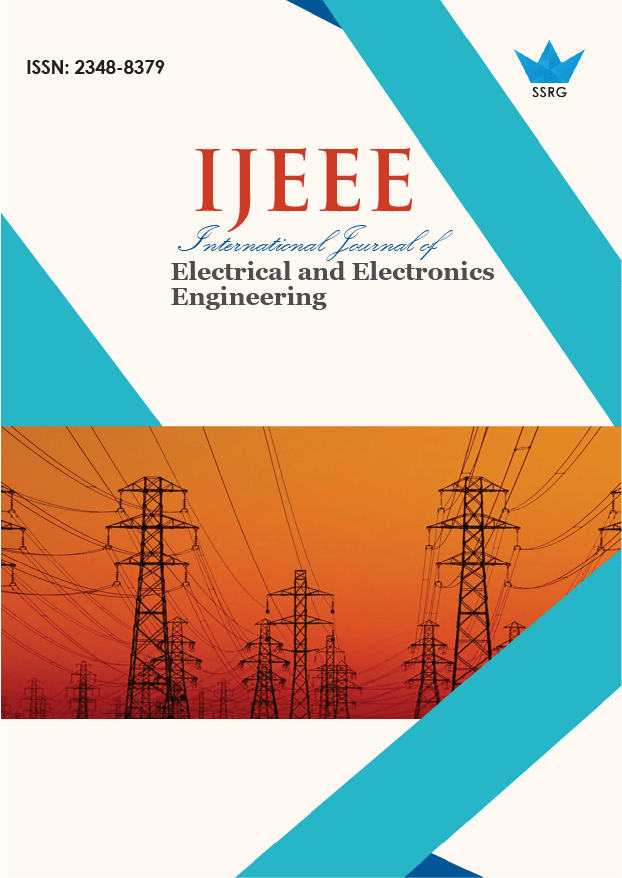Flexible Bidirectional Converter Connecting DC and AC Microgrids for Smart Grid

| International Journal of Electrical and Electronics Engineering |
| © 2025 by SSRG - IJEEE Journal |
| Volume 12 Issue 6 |
| Year of Publication : 2025 |
| Authors : Nguyen The Vinh |
How to Cite?
Nguyen The Vinh, "Flexible Bidirectional Converter Connecting DC and AC Microgrids for Smart Grid," SSRG International Journal of Electrical and Electronics Engineering, vol. 12, no. 6, pp. 158-168, 2025. Crossref, https://doi.org/10.14445/23488379/IJEEE-V12I6P113
Abstract:
Currently, implementing a hybrid micro-power system in the power system has received significant attention from recent researchers. The flexible connection and exchange of energy in independent or grid-connected multi-microgrid systems is studied for multi-function converters. In addition, the issue of appropriate energy management, saving and stabilizing the power system from distributed energy sources (renewable energy sources) is necessary to provide continuous supply to the loads. The current power system has mixed DC and AC microgrids integrating many sub-grids. The energy exchange between those grids requires basic energy converters such as DC/DC, DC/AC and AC/DC. This work presents a multifunction converter structure that integrates a two-way power conversion method in grid-connected or independent DC/DC/AC/DC for microgrids. In this converter system, the non-isolated form uses two-way power electronic locking technology derived from the basic principle of Flyback, Boost, Buck and full bridge converters. The power grids consist of two DC microgrids and one AC microgrid capable of grid connection and independent operation. Flexible operation is realized with the combination of 3 microgrids, so the converter ensures each specific case for efficient energy use from distributed sources. The results of the simulation and experiment in the laboratory are compared.
Keywords:
Bidirectional DC/DC converters, DC/AC converters, AC/DC converters, Batteries, Hybrid power systems.
References:
[1] Daniel E. Olivares et al., “Trends in Microgrid Control,” IEEE Transactions on Smart Grid, vol. 5, no. 4, pp. 1905-1919, 2014.
[CrossRef] [Google Scholar] [Publisher Link]
[2] F. Martin-Martínez, A. Sánchez-Miralles, and M. Rivier, “A Literature Review of Microgrids: a Functional Layer Based Classification,” Renewable and Sustainable Energy Reviews, vol. 62, pp. 1133-1153, 2016.
[CrossRef] [Google Scholar] [Publisher Link]
[3] Dan T. Ton, and Merrill A. Smith, “The US Department of Energy’s Microgrid Initiative,” The Electricity Journal, vol. 25, no. 8, pp. 84-94, 2012.
[CrossRef] [Google Scholar] [Publisher Link]
[4] Md Shafiullah et al., “Review of Recent Developments in Microgrid Energy Management Strategies,” Sustainability, vol. 14, no. 22, pp. 1-30, 2022.
[CrossRef] [Google Scholar] [Publisher Link]
[5] Altaf Q.H. Badar, and Amjad Anvari-Moghaddam, “Smart Home Energy Management System-A Review,” Advances in Building Energy Research, vol. 16, no. 1, pp. 118-143, 2020.
[CrossRef] [Google Scholar] [Publisher Link]
[6] Nikos Hatziargyriou et al., “Microgrids,” IEEE Power and Energy Magazine, vol. 5, no. 4, pp. 78-94, 2007.
[CrossRef] [Google Scholar] [Publisher Link]
[7] Yonghao Gui et al., “Passivity-Based Coordinated Control for Islanded AC Microgrid,” Applied Energy, vol. 229, pp. 551-561, 2018.
[CrossRef] [Google Scholar] [Publisher Link]
[8] Zhuangli Hu et al., “How Smart Grid Contributes to Energy Sustainability,” Energy Procedia, vol. 61, pp. 858-861, 2014.
[CrossRef] [Google Scholar] [Publisher Link]
[9] Jhojan A. Rodriguez-Gil et al., “Energy Management System in Networked Microgrids: An Overview,” Energy Systems, pp. 1-32, 2024.
[CrossRef] [Google Scholar] [Publisher Link]
[10] M. Vijayalakshmanan et al., “Microgrid Energy Management and Monitoring Systems Powered by Fuzzy Logic Maximum Power Point Tracking,” 2023 5th International Conference on Inventive Research in Computing Applications (ICIRCA), Coimbatore, India, pp. 1727-1732, 2023.
[CrossRef] [Google Scholar] [Publisher Link]
[11] Flemming Aarup, “Future Trends in DC/DC Converters for Telecommunications,” INTELEC '87 - The 9th International Telecommunications Energy Conference, Stockholm, Sweden, pp. 55-60, 1987.
[CrossRef] [Google Scholar] [Publisher Link]
[12] Andrija Stupar et al., “Multi-Objective Optimization of Multi-Level DC-DC Converters Using Geometric Programming,” IEEE Transactions on Power Electronics, vol. 34, no. 12, pp. 11912-11939, 2020.
[CrossRef] [Google Scholar] [Publisher Link]
[13] Felipe Ruiz et al., “Surveying Solid-State Transformer Structures and Controls: Providing Highly Efficient and Controllable Power Flow in Distribution Grids,” IEEE Industrial Electronics Magazine, vol. 14, pp. 56-70, 2020.
[CrossRef] [Google Scholar] [Publisher Link]
[14] Sezer Aslan, Ulas Oktay, and Nihan Altintas, “A Novel Non-Resonant Full-Bridge Multi-Output Topology for Domestic Induction Heating Applications,” Electronics, vol. 14, no. 3, pp. 1-22, 2025.
[CrossRef] [Google Scholar] [Publisher Link]
[15] Laysa L. Souza et al., “Single-Stage Isolated Half-Bridge/Full-Bridge Converter for DC/AC Applications,” 2021 IEEE Energy Conversion Congress and Exposition (ECCE), Vancouver, BC, Canada, pp. 2359-2363, 2021.
[CrossRef] [Google Scholar] [Publisher Link]
[16] Zeljko Ivanovic, and Mladen Knezic, “Modeling Push-Pull Converter for Efficiency Improvement,” Electronics, vol. 11, no. 17, pp. 1-17, 2022.
[CrossRef] [Google Scholar] [Publisher Link]
[17] Hangseok Choi, “Analysis and Design of LLC Resonant Converter with Integrated Transformer,” APEC 07 - Twenty-Second Annual IEEE Applied Power Electronics Conference and Exposition, Anaheim, CA, USA, pp. 1630-1635, 2007.
[CrossRef] [Google Scholar] [Publisher Link]
[18] Jing-Yuan Lin et al., “Analysis and Design of Three-Phase LLC Resonant Converter with Matrix Transformers,” Energies, vol. 15, no. 4, pp. 1-18, 2022.
[CrossRef] [Google Scholar] [Publisher Link]
[19] R.T. Naayagi, Andrew J. Forsyth, and R. Shuttleworth, “High-Power Bidirectional DC-DC Converter for Aerospace Applications,” IEEE Transactions on Power Electronics, vol. 27, no. 11, pp. 4366-4379, 2012.
[CrossRef] [Google Scholar] [Publisher Link]
[20] Tat-Thang LE, Ramadhan Muhammad Hakim, and Sewan Choi, “A High-Efficiency Bidirectional Single-Stage AC-DC Converter Under Wide Voltage Range for Fast Chargers,” IEEE Transactions on Power Electronics, vol. 38, no. 4, pp. 4945-4956, 2022.
[CrossRef] [Google Scholar] [Publisher Link]

 10.14445/23488379/IJEEE-V12I6P113
10.14445/23488379/IJEEE-V12I6P113